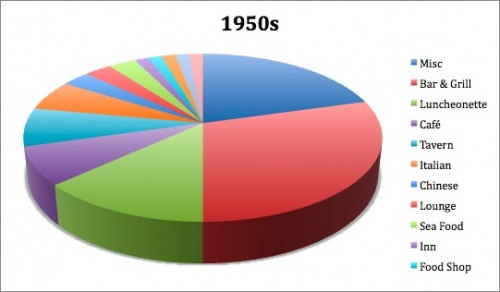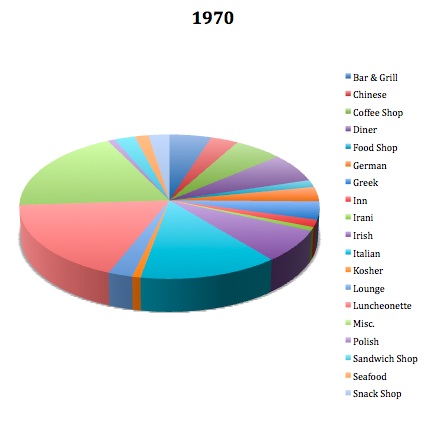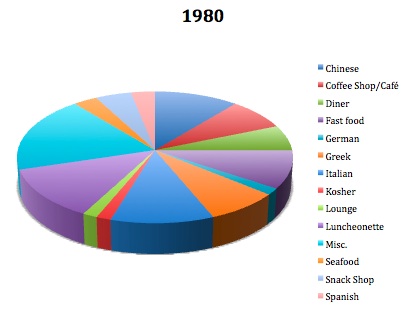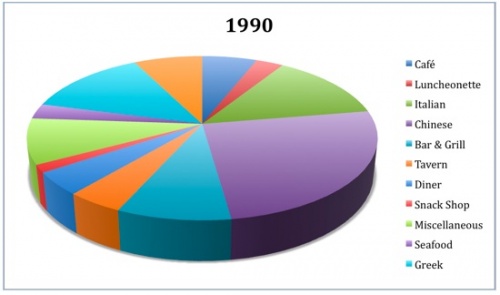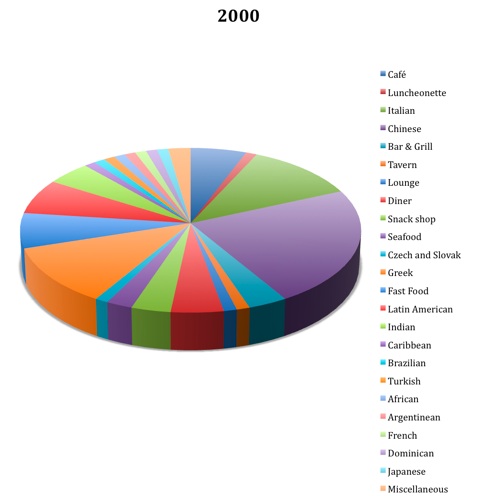| wiki | search |
Home
| Population Trends
| Gentrification
| Culinary Demography
| Architecture
Houses of Worship
| Art in Astoria
| Film Industry
| Steinway
| Index
| Contributors
Intro
The diversity of restaurants in Astoria can be attributed to Astoria’s diverse history. All of the people from different countries left a mark in Astoria’s restaurant trends. Besides some of the foods that became popular in all areas, many of the restaurants reflect the population.
The restaurant trend of Astoria started with a focus on American cuisine with a hint of Italian and Chinese restaurants during the 1950's. This trend continued till 1960's with increase in Italian restaurants. 1950's and 1960 are overwhelmingly characterized by bar & grill, and luncheonettes. Sadly, the data for 1965 was unavailable in the library.
The rise of Italian and Chinese restaurants continues into the 1970's and the 80's, when the overall number of restaurants grew along with introduction of new cuisines such as Greek, German, Iran, Irish, Polish and Kosher.
In the 1990’s and into the 2000’s Astoria’s restaurants became more and more diverse as new waves of immigrants from all around the world settle in Astoria. Along with the still popular diners, there is a rise in Japanese cuisine, French restaurant, Czechoslovakian, African cuisine, Indian restaurants, Latin American restaurants such as Dominican, Argentinian, Brazilian, and Caribbean, and even more Italian and Greek restaurants.
Method of Research
The data for the restaurant trends can be found on microfilms in the Queens Library at the Jamaica branch. Each restaurant can be found with its address, which shows if it is in Astoria. In many cases the name of the restaurant shows what it is. The name could site a specific kind of restaurant such as diner, or the name’s origin could indicate the type of restaurant.
Trend Graphs
Note: All data are tallied and comprised from the restaurant section of the yellow pages book on Queens. Each data reflects hand collected data which may be subjected to various variations. Any restaurants that could not be categorized by its name were put into miscellaneous category.
| The total number of restaurants stays relatively constant throughout 1950s to 2000, but there is a major increase in the number from 1955 to 1970. We speculate that this is due to the large influx of Italians and Greeks as well as an increase in Arab population during 1970s. During 1970, many ethnic restaurants blossomed suggesting the diversifying of the population in Astoria. As former immigrant groups move out of Astoria to suburban neighborhoods, some of the restaurants closed down causing the decline in total number of restaurants after the 1970s. The small rise in total number of restaurants in the end is due to the increase number of Astoria's Latino population. |
Individual Pie Graphs
| The restaurants are more focused on American cuisine such as tavern, bar & grill, diner and luncheonette. |
| The 1960s also illustrates an Astoria that is more focused on American cuisine such as tavern, bar & grill, luncheonette, and diner. But we see an increase in Italian restaurants. The Italian restaurants emphasize the rise of Italian population in Astoria. But we do not see an increase in Greek restaurants although there is an increase in the Greek population. During 1960s, sandwich shop is formed to mark a start for portable food. |
| Compared to the different types of restaurant in 1960, there was a great increase in variety in 1970. There was a rise in ethnic restaurants which was due to the increase of different immigrant groups coming into Astoria. |
| The restaurants of the 1980s start to really become diverse. There is a decrease in luncheonettes and the number of different restaurants begin to even out. We see an increase in Greek, Italian and German restaurants. There is also an increase in Chinese restaurants and various different fast food stores. |
| In the 1990's we can see a rise in fast food restaurants and Chinese restaurants. There is a rise in the Latin American population in the 1990's but we do not see the increase in this graph because it was take just before the increase. |
| In the 1990s we can see that the restaurants in Astoria became more diverse. This may be due to the fact that the population became more diverse. Also, different ethnic foods became more popular. An example would be the Japanese Cuisine. Sushi became very popular in the 90s but there was not a big rise in the Japanese population. Due to the increase in the Latin American population in the 1990's we see an in crease in Latin American restaurants by year 2000. |
Notable Restaurants
Czech and Slovak
Zlata Praha
"Save yourself some airfare: The food here is authentic, flavorful, and much better than any of the more touristy places in Prague itself. — Chloe Osborne1"
 Diner
DinerBel-Aire-Diner
"Items from the fryer, such as the remarkably light calamari and crisp fries, fare well, but sandwiches are less successful... - Lauren Longhine2"
Italian
Piccola Venezia
"...The cooks are masters of sauce, especially the garlic-laden product ladled over hot seafood antipasto, and the mercifully non-gloppy traditional brown sauce on the osso buco... - Steven A.3"
 Sandwiches
Sandwiches Sal, Kris & Charlie's Deli
"This is the best place to get sandwiches I have found in years. The specials* are amazing, from shrimp salad to the Bomb which consists of every cheese and meat you can think of with a plethora of peppers and other nice sandwich-type things...- Kevin A.4"
Greek
Cavo
"Astoria ranks near the top when it comes to sheer numbers of Greek restaurants and sidewalk cafes. Cavo combines both...- William Grimes5"
Uncle George's Greek Tavern
"...In addition to barbecued pork and chicken, the kitchen prides itself on seafood, such as shrimp covered in melted feta, and a shimmery, whole grilled porgy, whose mild flesh is filled with tiny bones, but enhanced by a crisp, charred skin. The roast leg of lamb, a boneless, yielding piece of meat covered in gravy, has a simple, homecooked appeal, and the lemon-brightened baked potato is a standout among sides... - Karen Hudes6"
 Japanese
JapaneseWatawa Sushi
"...The menu – bolstered by ultra-fresh, visually appealing sushi – also includes the usual salads, tempura, yosenabe stews, hot pots, and sushi rolls and platters. Its sole surprise is "live lobster teriyaki," which conjures a disturbing mental picture, but in fact is merely a steamed and sauced crustacean...- Karen Tina Harrison7"
References
1. "Zlata Praha - Astoria - New York Magazine Restaurant Guide." New York Magazine -- NYC Guide to Restaurants, Fashion, Nightlife, Shopping, Politics, Movies. 10 May 2009 <http://nymag.com/listings/restaurant/zlata-praha/>.
2. "Bel-Aire Diner - Astoria - New York Magazine Restaurant Guide." New York Magazine -- NYC Guide to Restaurants, Fashion, Nightlife, Shopping, Politics, Movies. 11 May 2009 <http://nymag.com/listings/restaurant/bel-aire-diner/>.
3. "Piccola Venezia - New York Magazine Restaurant Guide." New York Magazine -- NYC Guide to Restaurants, Fashion, Nightlife, Shopping, Politics, Movies. 10 May 2009 <http://nymag.com/listings/restaurant/piccola-venezia/>.
4. "Sal, Kris, & Charlie's Deli - Queens/Long Island City - Astoria, NY." New York Restaurants, Dentists, Bars, Beauty Salons, Doctors. 11 May 2009 <http://www.yelp.com/biz/sal-kris-and-charlies-deli-astoria>.
5. "Cavo - Queens - Details and Reader Reviews - The New York Times." The New York Times - Breaking News, World News & Multimedia. 10 May 2009 <http://events.nytimes.com/gst/nycguide.html?detail=restaurants&id=1060246348671>.
6. "Uncle George's Greek Tavern - Astoria - New York Magazine Restaurant Guide." New York Magazine -- NYC Guide to Restaurants, Fashion, Nightlife, Shopping, Politics, Movies. 10 May 2009 <http://nymag.com/listings/restaurant/uncle-georges-greek-tavern/>.
7. "Watawa - Astoria - New York Magazine Restaurant Guide." New York Magazine -- NYC Guide to Restaurants, Fashion, Nightlife, Shopping, Politics, Movies. 11 May 2009 <http://nymag.com/listings/restaurant/watawa/>.
Home
| Population Trends
| Gentrification
| Culinary Demography
| Architecture
Houses of Worship
| Art in Astoria
| Film Industry
| Steinway
| Index
| Contributors



